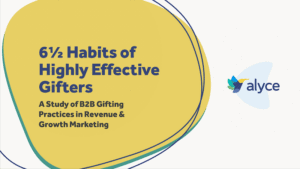
As we work with businesses to help them build tighter bonds with your prospects and customers, one of the most common questions we hear when talking with Sales and Marketing leadership during the sales process is, “how is personal gifting different from direct mail?”
While there is a clear similarity – both concepts involve sending someone something – a personal gifting strategy goes far beyond the traditional tactics of direct mail marketing.
Before we explore the differences, let’s level set on the basics: what is direct mail marketing?
A Brief History of Direct Mail Marketing
Historians believe the earliest recorded example of advertising in Direct Mail dates back to 1000 B.C in Thebes, Egypt. This ancient advertisement, written on papyrus by “Habu the Weaver,” offered a reward in exchange for information on or the return of a runaway slave, Shem. Should someone find Shem, they were asked to return him to Habu’s shop “… where the best clothes are woven to your desire.”
While Shem was never returned and the reward never paid out, this highly complimentary review of Habu’s shop is considered to be the first physical advertisement widely distributed to consumers. Subtly woven into the copy, historians believe this is the oldest documented brand awareness campaign sent through direct mail.
What is Direct Mail Marketing?
Direct mail marketing is the one-to-many distribution of physical advertisements to prospects and customers with the intention of earning or retaining their business.
The Direct Marking Association estimates that US markets spend around $44.2 billion on direct mail, making it the second most invested offline marketing channel. From coupons to brochures, catalogs, and dimensional mailers, direct mail has long served as a way to drive brand awareness.
In the last 3 decades, with the introduction and explosion of digital marketing and selling, new and innovative ways have emerged for brands to drive awareness and interact with their audiences. As the fragmented multi-channel approach has paved the way for an omnichannel experience, technologies have enabled sales reps and marketers alike with a host of new data points to capture broader audiences and accelerate sales cycles.
With its data disconnected from the omnichannel approach, tracking the ROI from a direct mail channel is challenging at best. Which begs the question: does direct mail actually pay off?
Does Direct Mail Actually Work
Since 2016, the overall volume of direct mail has been trending downward. In 2019, direct mail saw the largest drop in with a decrease in volume by 7.4%. With a drop in investments, is this a leading indicator that marketers and sales reps are losing faith in the channel?
Not in the least.
While traditional direct mail is one of the least effective channels when reaching target audiences, the entire channel of direct mail itself isn’t completely out of the running. Marketing Charts reported in 2019 that direct mail – when integrated within a multi-channel strategy and contextualized within the customer journey – outperformed some of the most reliable channels such as email, outbound business development, and SEM.
All this to say: it’s not direct mail that’s the issue, it’s the approach to traditional mail that’s flawed.
The Fundamental Flaws of Traditional Direct Mail
“I suppose it is tempting, if the only tool you have is a hammer, to treat everything as if it were a nail.”
– Abraham Maslow, The Law of Instrument
Given a little to no evolution in the direct mail channel, the proverbial “hammer” of direct mail is overall lacking in its effectiveness. Let’s examine the fundamental flaws of direct mail.
There is no close-loop reporting for direct mail.
Direct mail marketing leaves gaping holes in the lead flow process. Revenue Operations teams looking to build a closed-loop reporting system for your marketing and sales teams initiatives have a hard time reporting on the end-to-end performance of direct mail.
Even if you’ve paid extra for mail tracking on your dimensional mail, there is no native way to confirm that your mail found its intended recipient. Once a piece of direct mail is sent, it’s on the recipient to take action and for Revenue Operations that hole in the data makes it impossible to optimize this channel for engagement and ultimately conversions.
No address validation system.
Combing an increasingly remote workforce, companies with multiple offices, and employees traveling on the road, and your direct mail is likely sitting untouched somewhere in an empty mailroom.
While mail tracking verifies if your dimensional mail found its way to an office, there is no native way to confirm that your mail found its intended recipient. Not only is it not possible to track if direct mail found its way to the hands of your intended recipient, but it’s also difficult to track if what you sent got their attention.
Direct mail is too focused on your brand.
No one walks into the bar and spends time with the person only talking about themselves. To that effect, why would a prospect or customer want to join a conversation only about your company?
Direct mail is a one-way communication device and the primary topic of conversation is you.
By sending direct mail covered in your logos and branding, you’re too focused on talking about yourself and missing an important opportunity to spark a dialogue. Not to mention, most folks don’t like the things you send.
Most direct mail ends up in the trash.
One-size-does not fit all with direct mail. Despite this, most brands are still sending the same exact item to every single recipient on their target account list.
This means the items sent through direct mail fall into three categories:
- Items recipients haven’t asked for
- Items recipients don’t need, and
- Items recipients don’t want.
It should be no surprise that 65% of all direct mail ends up in the trash. It costs local and state governments $320 million to dispose of that trash every year. With 100 million trees being harvested and 28 million gallons of water being used every year to manufacture it – it’s safe to say:
Direct mail is terrible for the environment.
What is Personal Gifting?
Personal gifting is the sales and marketing strategy that uses gifts to create one-to-one moments with your prospects and customers – all at scale.
A strategy within the personal experience approach, personal gifting helps you build rapport, earn trust, and drive loyalty with your key accounts throughout their customer journey. From sales prospecting to event experiences, customer happiness, and retention, personal gifting accelerates the performance of your channels by fostering a lasting emotional connection to your brand.
How Personal Gifting Differs from Direct Mail
Personal gifting puts the person before the persona and focuses on building relevancy into experience around the recipient, not around your brand.
The more relevant the experience, the more emotional connectivity there is to your brand. The higher the emotional connectivity, the higher the engagement – and ultimately conversion rates – for your sales and marketing teams.
To create a relevant experience, the gifts you send should be uniquely selected for each person. This will require researching each gift recipient to understand their passions outside of their 9-to-5 and in their 5:00 pm to 9:00 am – or the #5to9™.
While the impact is deep and wide, researching gift recipients and hand-selecting gifts per person can be time-consuming. To preserve a personal experience, your business will need a platform that can enable personal experience at scale.
Alyce: The Personal Gifting Platform
Alyce is an AI-powered personal gifting and swag platform that helps sales, marketing teams build relationships with their prospects and customers at scale.
Send the perfect gift every time.
Our platform saves your team time by using AI to conduct personal interest research on your contacts. Based on that research, our platform will make gift recommendations from our marketplace of 1000+ gifts and charities sourced to complement your recipient’s #5to9™.
With the ability to exchange or donate the gift, your recipient will never receive something they don’t need or want. This sustainable solution means none of your gifts ( and budget ) will end up in the trash.
Monitor the end-to-end performance of your strategy.
Beyond just the gift selection our platform provides the closed-loop reporting your RevOps team will love. Real-time tracking of gift invitations and visibility into open rates, acceptance rates, and meetings booked, provides the insight your team needs to the gift recipient experience above all else.
Never send a gift to the wrong place.
Native to the gift-receiving experience, Alyce allows your gift recipient to validate and/or update their preferred mailing address. Address validation means your marketing budget isn’t wasted sitting alone and lonely in an empty mailroom.
Bringing Efficiency and Scale to a Traditional Channel
Direct Mail has been around for centuries. As one of the oldest forms of marketing, it’s approach has seen little to no evolution.
Until now.
Alyce offers you the ability to build bonds with your prospects and customers by enabling you to send gifts at scale.
We don’t think of ourselves as direct mail: never have, never will. Direct mail marketing is interruptive, in many ways immeasurable, and its one-to-many approach is antiquated. By adopting a personal gifting approach through Alyce’s platform, you’ll produce higher engagement and conversion rates meaning more pipeline with your prospects and higher retention rates with your customers.






